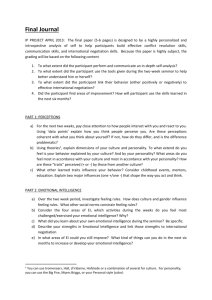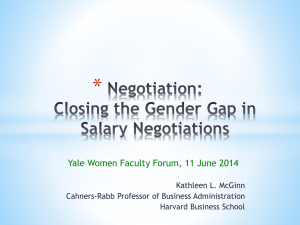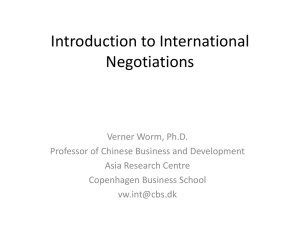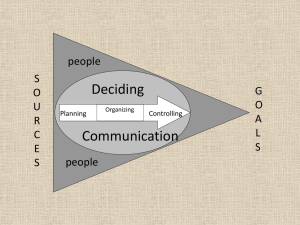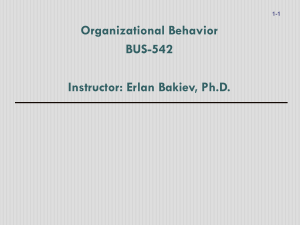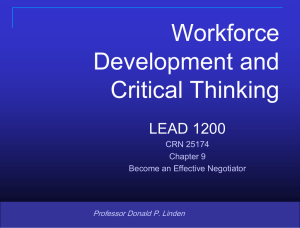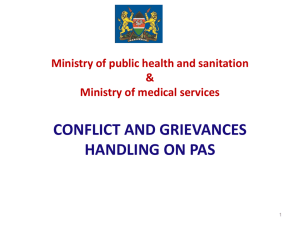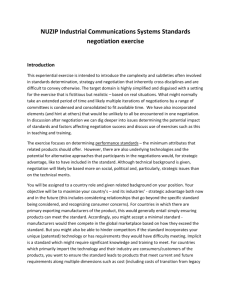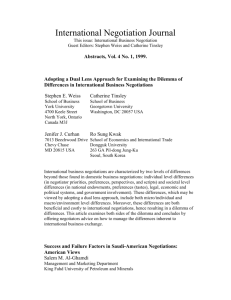Ms.Neena Bansal Krishna
advertisement
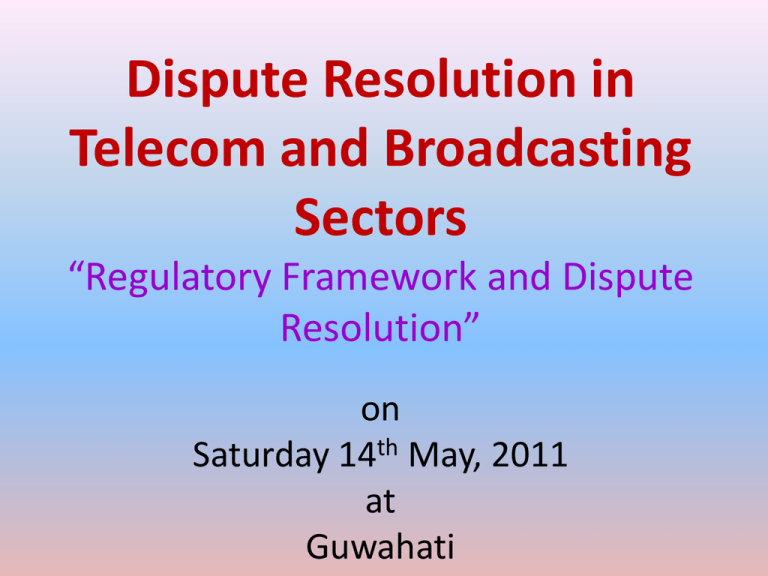
Dispute Resolution in Telecom and Broadcasting Sectors “Regulatory Framework and Dispute Resolution” on Saturday 14th May, 2011 at Guwahati Negotiation and Mediation Presented by Ms. Neena Bansal Krishna Secretary / Director (ADR) www.ReadySetPresent.com Page 3 DEFINITION Defined as process of reciprocal communications between participants for purpose of achieving or satisfying a participant’s claims, need or interests in face of competing, claims, needs or interests. Process of bargaining between two (or interests. more) Helps parties to arrive at an agreement satisfactory to both parties. 4 Involves : • a complex set of human behavior Requires : • An understanding of communications, persuasions; • behavioral theories, psychology; • conflict resolution methods; • flexibility, creativity and reasonableness. Listening is most powerful negotiation skill All negotiations involve two levels : Vs. Works at various stages of negotiation process : • Which strategies are planned to be used; which are actually chosen • The way other party and its intentions are perceived. • Willingness to reach agreement Whether to settle or not, depends on emotional factors Positive emotions facilitate : • reaching an agreement • help to maximize gains Negative emotions can cause : • intense irrational behaviour • Conflict to escalate • negotiations to break Approaches to negotiation : Good Negotiator blends both approaches and shift according to circumstances Both are not mutually exclusive nor one superior to other Both may be followed Neither approach is inherently more effective than other. Six steps of Negotiation Process State the problem Restate the issues Decide on best solution Identify real needs Present possible solution - options Reach consensus Fundamental elements of negotiation process : Pre bargaining - Preparation 1. Gather information 2. Leverage Evaluation – time factor, urgency, availability 3. Analysis : What are the issues; What are the ‘needs’ wants / greed Understand others needs 4. To know strengths and weaknesses of case 5. Goals and Expectations 6. Develop rapport Phase-I Fundamental elements of negotiation process : Bargaining Phase-II Opening Offer : 1. More than what you expect. 2. Should be reasonable and constructive. 3. Have justifications. 4. Keep in mind both goals and bottom lines. 5. Break problem into issues. 6. Explore options. 7. Remember principles of fairness. Negotiation dance Opening Offer (Rs.) 16,000 17,000 17,500 Value to be distributed Rs.4000/What do you want. Market Price (Rs.) Where should be the first offer. 19,000 18,000 When to make first move 17,750 17,875 17,935 20,000 18,250 How to close. Rs.18000/- 18,125 18,065 SELLER’S WALK AWAY POSITION Rs17,500 Rs 16,ooo Book Sale Exercise BUYER’S WALK AWAY POSITION Rs18,500 Rs20,000 Fundamental elements of negotiation process : CLOSURE Don’t blow end game : • Don’t rush or delay • Strike when iron is hot. Wise agreement : • Should be efficient. • Improve relationships • Don’t fuss over petty issues. • Meets interests of both parties. Don’t ignore emotional closure Phase-III Tricks of Negotiations : 1. Few trade off. 2. Concessions : logrolling make concessions of low priority in exchange for concessions on issue that is of more value. 3. Bridging the gap 4. Speak their language Tricks of Negotiations : 5. Make dependence a factor 6. Explain demands – Use objective criteria 7. Facts and statistics 8. Higher Authority 9. Taking Risks : Trust is important Negotiate from Strength "When others sense your willingness to walk away, your hand is strengthened. Sometimes you are better off not getting to yes.“ Negotiate Effectively… Even When You are Weak Reframe Weakness as Strength • 1912 Presidential campaign • Used photo of Roosevelt without permission • 3 million copies printed • Penalty $1/copy • Telegram: planning to print 3 million copies of campaign speech. Excellent opportunity for photographers. • How much are you willing to pay us to use your photograph? • “Appreciate opportunity but can afford to pay $250.” • Don’t reveal the weakness of your alternatives • Having weak alternatives is not so bad if the other side’s alternative is also weak • Being weak is bad. Feeling weak can be fatal. • The person who defines the negotiation, wins the negotiation Despite best efforts sometimes negotiations reach at impasse Parties realise resolution of disputes can serve better but do not reach to settlement. A negotiator to examine why negotiations failed and try to overcome barriers 25 Risk aversion and loss aversion – One party takes calculated steps to maximize one sided gains. conflict of interests between agents goal and objectives and those of his principles. Due to unwarranted assumptions about motives and intentions of other parties. 26 Reasons For Negotiation Breakdown Techniques Poor negotiation skills Help parties with framing offers Unrealistic Expectations Issues of Principles Reality testing Emotions, ego, pride Acknowledge and allow expression of emotions Failure of communications Poor decision making Act as a conduit for clear and safe communications Settlement panic Help parties to visualizes future beyond dispute Focus parties on practical considerations Shape agreement Mediation Mediation is a voluntary process in which a neutral third party - a mediator - facilitates through communication and negotiations, the parties to arrive at a mutually acceptable amicable agreement to their dispute. 28 A mediator : facilitates communication and negotiations , promotes understanding, assists parties to identify interests and needs, uses creative problem solving techniques , enables parties to reach their own agreement. 29 Mediator as Negotiator Utilizes negotiation skill To understand negotiation tactics To help parties past hurdles to make first offer To manage parties expectations To exchange information tactically To use creative problem solving techniques Thank you 31


